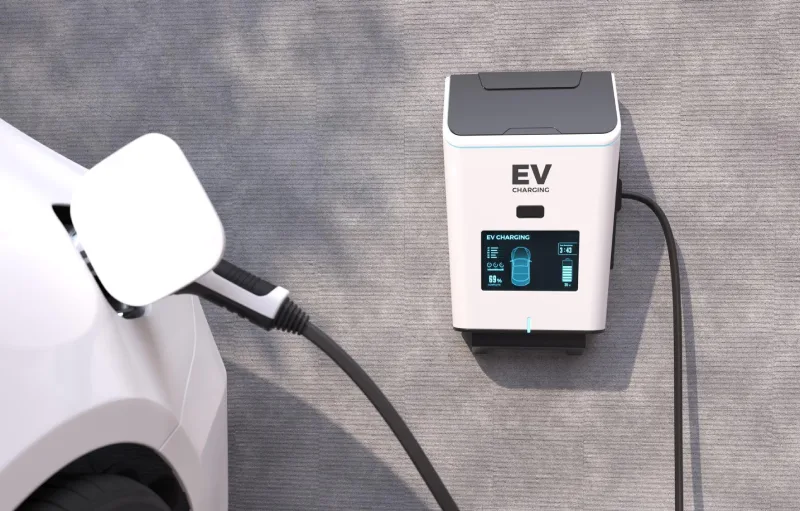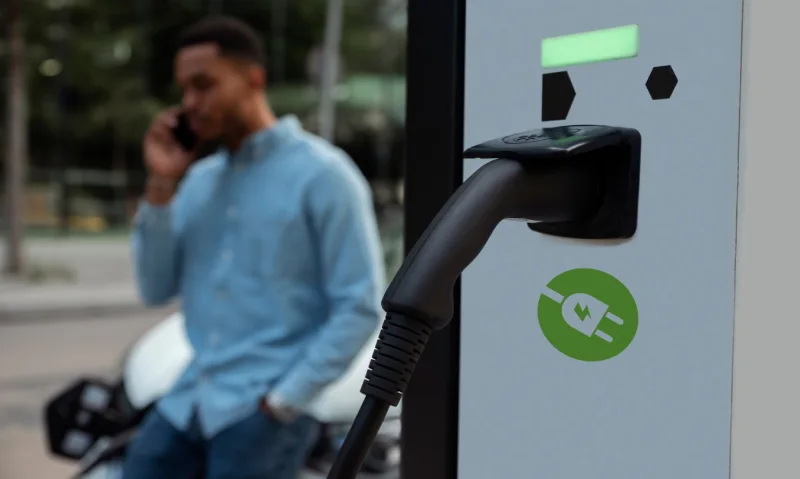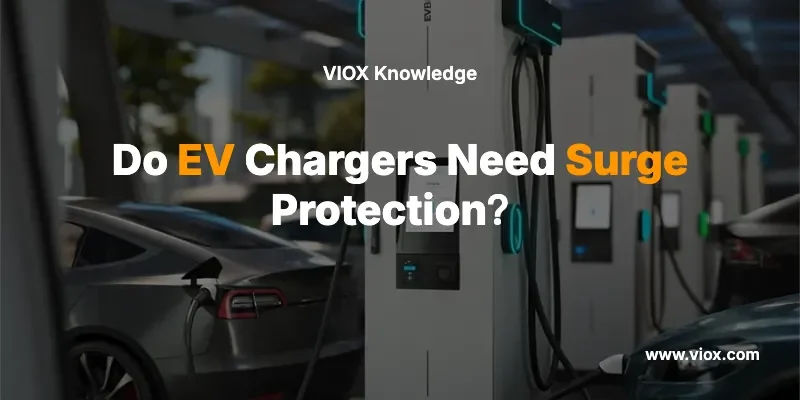The Short Answer: Yes, EV Chargers Need Surge Protection (But You Can Opt Out)
Konklusjon foran: Modern electrical codes require surge protection devices (SPDs) for new EV charger installations, but homeowners can choose to opt out. However, the minimal cost of surge protection ($150-$500) versus potential damage costs ($2,000+) makes installation a smart investment for protecting both your expensive EV charger and vehicle.
New wiring regulations in the UK (18th Edition Amendment 2) that came into effect on September 27, 2022, require surge protection devices for all new electrical circuits, including EV charger installations. Similarly, the US National Electrical Code (NEC) 2020 and 2023 editions require surge protection for services supplying dwelling units, which includes homes with EV charging stations.
The regulations recognize that while surge protection is crucial for electrical safety, homeowners should have the final say in their installations. This guide will help you understand why surge protection matters, what it costs, and how to make the right decision for your EV charging setup.
Understanding Surge Protection for EV Chargers
What Are Surge Protection Devices (SPDs)?

Overspenningsvern are electrical safety components designed to protect your home’s electrical systems from voltage spikes. A surge protector shields electrical appliances from voltage spikes by blocking or shorting any excess voltage. When it comes to EV chargers, SPDs act as a critical line of defense against potentially damaging electrical events.
Think of an SPD as an electrical pressure relief valve. When a power surge occurs—whether from lightning, grid switching, or equipment failures—the device detects the excess voltage and safely diverts it to ground, preventing it from reaching your expensive EV charging equipment.
Why EV Chargers Are Vulnerable to Power Surges

Modern EV chargers contain sophisticated electronic components that manage the complex process of safely charging your vehicle’s battery. EV chargers rely on advanced circuitry to safely and efficiently charge your electric car’s battery, and a power surge can overload and permanently damage those components.
Several factors make EV chargers particularly susceptible to surge damage:
- Følsom elektronikk: Today’s smart chargers include WiFi connectivity, smartphone apps, load balancing features, and safety monitoring systems—all vulnerable to electrical spikes.
- Outdoor Exposure: EV chargers are typically installed outside, making them more susceptible to lightning strikes and weather-related electrical disturbances.
- High Power Circuits: Level 2 chargers operate on 240V circuits with 30-50 amp capacity, making them prime targets for surge events that can cause significant damage.
- Continuous Connection: Unlike other appliances, EV chargers remain connected to your electrical system 24/7, creating constant exposure to potential surge events.
Legal Requirements: What the Regulations Say
UK Regulations (18th Edition Amendment 2)
The new 18th Edition Amendment 2 of the Wiring Regulations came into effect on September 27, 2022, stating that all new electrical circuits must have Surge Protection Devices (SPDs) fitted. Since EV charger installations require new dedicated circuits, this regulation directly applies to residential EV charging installations.
However, the regulations include an important provision: customers can opt out of having a Surge Protection Device at the time of their EV charger installation if they wish to do so, meaning the overall decision is down to you as the customer.
Key UK Requirements:
- SPDs required for all new electrical circuits
- EV charger installations fall under this requirement
- Customer opt-out allowed with proper documentation
- Professional installation by qualified electricians mandatory
US Regulations (NEC 2020/2023)
The United States follows the National Electrical Code, which has evolved to require surge protection in residential applications. NEC 2023 Section 230.67(A) requires that all services supplying dwelling units shall be provided with a surge-protective device (SPD).
NEC Requirements Include:
- Type 1 or Type 2 SPD required for dwelling units
- Protection must be integral to service equipment or located immediately adjacent
- Requirements expanded in 2023 to include multifamily dwelling units, dormitory units, guest rooms and guest suites
State Adoption Varies: As of February 2023, the 2020 NEC is in effect in twenty-five states, while other states use older versions. Check with your local authority having jurisdiction for specific requirements in your area.
International Standards and Best Practices
While regulations vary globally, the trend toward mandatory surge protection reflects growing recognition of electrical safety importance in our increasingly electronic world. Countries like Australia, Canada, and Germany have similar requirements developing for residential electrical installations.
Types of Surge Protection for EV Chargers
Type 1 SPDs (Service Entrance Protection)
Type 1 SPDs are installed before the main device in the load center and provide the first line of defense against external surges from the utility grid. These devices typically mount at your electrical meter or main service panel.
Best for:
- Homes with overhead power lines
- Areas with frequent lightning activity
- Properties with existing lightning protection systems
Type 2 SPDs (Load Center Protection)
Type 2 SPDs are positioned on the load side of the main disconnect and are the most common choice for residential EV charger protection. These surge protection devices are normally fitted in the home fuse box, or consumer unit, at the same time as the charger is installed.
Fordeler:
- Protects against both external and internal surges
- Easier installation during EV charger setup
- Covers the entire home electrical system
- Most cost-effective for residential applications
Type 3 SPDs (Point-of-Use Protection)
Type 3 devices provide protection at individual outlets or equipment. Type 3 plug-in surge protectors do not provide adequate protection on their own for EV chargers but can serve as supplementary protection.
Whole House vs. Dedicated EV Circuit Protection
Per the NEC 2020, a UL1449 Listed SPD must be installed at the incoming 120/240Vac main service panel, providing what is referred to as a “Whole House Surge Protector”. This approach protects your EV charger while simultaneously safeguarding all other electrical devices in your home.
The Real Costs: Investment vs. Risk
SPD Installation Costs
UK Pricing:
- SPD devices: £30-£160 typical range
- Professional installation typically included in EV charger setup
- Small additional cost when installed during EV charger installation
US Pricing:
- Decent whole house surge protector: $300 for device, $200 for installation
- Realistic total cost: $500 on the high end
- Some installations as low as $250 including parts
Cost of EV Charger Damage
Without surge protection, electrical damage can be catastrophic and expensive:
- EV Charger Replacement: $800-$2,500+ for quality Level 2 chargers
- Vehicle Electronics: Modern EVs contain thousands of dollars in sensitive electronics
- Home Electrical Damage: Surges can damage multiple appliances and require extensive rewiring
If damage occurs from an electrical surge, the cost to replace or repair the damaged charging equipment is significantly higher than the small cost of an SPD.
Insurance and Warranty Implications
Critical Consideration: It is important to read the small print of manufacturers’ product warranties, and home insurance policies, that may not be valid if such a protective device is not installed.
Many EV charger manufacturers and insurance companies may deny claims for surge-related damage if proper protection wasn’t installed. Payments or replacement products may not be issued if a claim must be made, so it is well worth understanding the significance of electrical surge protection when it comes to insurance cover and warranty claims.
Benefits Beyond Compliance
Protecting Your Investment
Equipment Longevity: SPDs extend equipment life by knocking down both large and small electrical surges that can gradually degrade electronic components over time.
Vehicle Protection: Modern EVs are essentially computers on wheels. A surge that enters through the charging cable can potentially damage your vehicle’s battery management system, onboard computer, or other expensive electronic components.
System Reliability: Proper surge protection ensures consistent, safe charging performance and reduces the likelihood of unexpected charger failures.
Peace of Mind
Weather Protection: Lightning strikes, faulty electrical equipment or wiring, and restoration of power after an outage are all common culprits for power surges. SPDs provide protection against all these scenarios.
24/7 Protection: Even when you’re not actively charging, your EV charger remains connected to your electrical system. Surge protection provides round-the-clock safety monitoring.
Future-Proofing: As home electrical systems become increasingly sophisticated with smart home technology, whole-house surge protection becomes even more valuable.
Common Causes of Power Surges Affecting EV Chargers

Lynet slår ned
Lightning strikes are among the most common causes of electrical power surges. Even indirect strikes on nearby power lines can send damaging voltage spikes through the electrical grid to your home.
Risk Factors:
- Geographic location (Florida, Texas, Colorado have highest lightning activity)
- Overhead vs. underground power lines
- Proximity to tall structures or open areas
Grid-Related Surges
Power Restoration: When electricity is restored after outages, the sudden influx of power can create voltage spikes.
Equipment Switching: Utility companies regularly switch large electrical equipment on and off, potentially creating surges that travel through power lines.
Grid Instability: Aging electrical infrastructure and increasing demand can create voltage fluctuations that stress connected equipment.
Internal Electrical Issues
Large Appliance Cycling: When high-power appliances like air conditioners or electric water heaters turn on and off, they can create internal surges within your home’s electrical system.
Faulty Wiring: Deteriorating electrical connections or damaged wiring can create dangerous voltage spikes that surge protection helps contain.
Installasjonshensyn
Krav til profesjonell installasjon
Qualified Electricians Only: It is imperative that EV chargers are installed by qualified electricians who have specific training in EV charge point installation. The same applies to surge protection devices.
Sertifiseringskrav: Look for electricians certified in EV charger installation who understand current electrical codes and surge protection requirements.
Sikkerhet først: Dealing with electricity carries inherent risks, underscoring the necessity for professional installation.
Optimal Placement Strategies
Main Panel Installation: Most residential SPDs install at the main electrical panel, providing comprehensive protection for the entire home including the EV charger circuit.
Proper Grounding: The SPD ground connection should use a dedicated conductor to established building/service ground for optimal performance.
Wire Run Considerations: Shorter wire runs between the SPD and supply conductors provide better surge response.
Choosing the Right SPD
Joule Rating: For EV chargers, a minimum rating of 2000 joules is recommended to handle the energy from significant surge events.
Clamping Voltage: Look for a clamping voltage of around 400V for optimal protection specific to EV charging applications.
Svartid: A good surge protector should react in less than a nanosecond to provide effective protection.
Making the Decision: Do You Need SPD for Your EV Charger?
Risk Assessment Factors
Geographic Lightning Risk: Areas with frequent thunderstorms benefit most from surge protection. Check local lightning strike frequency data.
Power Grid Reliability: Regions with aging electrical infrastructure or frequent outages have higher surge risk.
Investment Protection: Consider the combined value of your EV charger ($800-2,500) and vehicle electronics (potentially thousands) when weighing protection costs.
When You Can Opt Out (And Why You Shouldn’t)
While regulations allow opting out, most reliable advice leans heavily towards including surge protection during the installation of EV chargers. The minimal cost compared to potential damage makes surge protection a wise investment.
Opt-Out Documentation: If you decide to proceed without having a surge protection device fitted during the installation, you may be asked to sign a document that acknowledges that you have been informed of the potential risks.
Professional Recommendations
If qualified electricians recommend installing a surge protection device, it is certainly worth acting on their advice. These professionals understand local electrical conditions and code requirements better than anyone.
Installation Process and Maintenance
What to Expect During Installation
Timeline: SPD installation typically adds 30-60 minutes to an EV charger installation appointment.
Minimal Disruption: Installation usually requires brief power interruption while connections are made at the main panel.
Testing: Professional installers will test the SPD to ensure proper operation before completing the job.
Ongoing Maintenance Needs
Monitoring: Most modern SPDs include indicator lights showing operational status.
Replacement Indicators: SPDs can wear out after protecting against surges and may need replacement every 5-10 years.
Professional Inspection: Include SPD status in regular electrical system inspections.
Ofte stilte spørsmål
Does my EV charger have built-in surge protection?
EV chargers do not have a built-in SPD – the SPD is an external device installed by your electrician, usually at the consumer unit. While some chargers include basic electrical protection features, they don’t provide comprehensive surge protection.
Can I install surge protection myself?
No. SPD installation requires working with your main electrical panel and should only be performed by qualified, licensed electricians. Improper installation can create safety hazards and void warranties.
Will surge protection affect my EV charging speed?
No. Properly installed SPDs don’t affect normal electrical operation or charging speeds. They only activate during surge events to protect your equipment.
What happens if I opt out of surge protection?
You assume full financial responsibility for any surge-related damage to your EV charger, vehicle, or home electrical system. Insurance and warranty claims may also be denied.
How often do surge protection devices need replacement?
SPDs typically last 5-10 years but may need replacement sooner if they’ve protected against multiple surge events. Modern devices include status indicators to show when replacement is needed.
Conclusion: Protecting Your EV Investment
The question isn’t really whether EV chargers need surge protection—electrical codes increasingly require it for good reason. The real question is whether you’re willing to accept the significant financial and safety risks of opting out.
Key Decision Factors:
- Cost-Benefit Analysis: $150-$500 protection vs. $2,000+ potential damage
- Regulatory Compliance: Required by modern electrical codes with opt-out provisions
- Insurance/Warranty Protection: May be required for coverage validity
- Peace of Mind: Protection against unpredictable electrical events
Our Recommendation: Install surge protection during your EV charger installation. SPDs represent a smart investment, safeguarding your home, your assets and ensuring compliance with safety regulations.
The minimal additional cost provides comprehensive protection for one of your most expensive home electrical installations while ensuring compliance with current safety standards. When qualified electricians recommend surge protection, it’s wise to listen.
Ready to Install Your EV Charger Safely?
Contact qualified, certified electricians in your area who understand both EV charger installation and current surge protection requirements. Get multiple quotes that include surge protection to ensure you’re getting the best value for comprehensive electrical safety.
Protect your investment. Protect your home. Charge with confidence.
Relatert
Hva er en overspenningsvernenhet (SPD)
Overspenningsvern: Fordeler og ulemper


